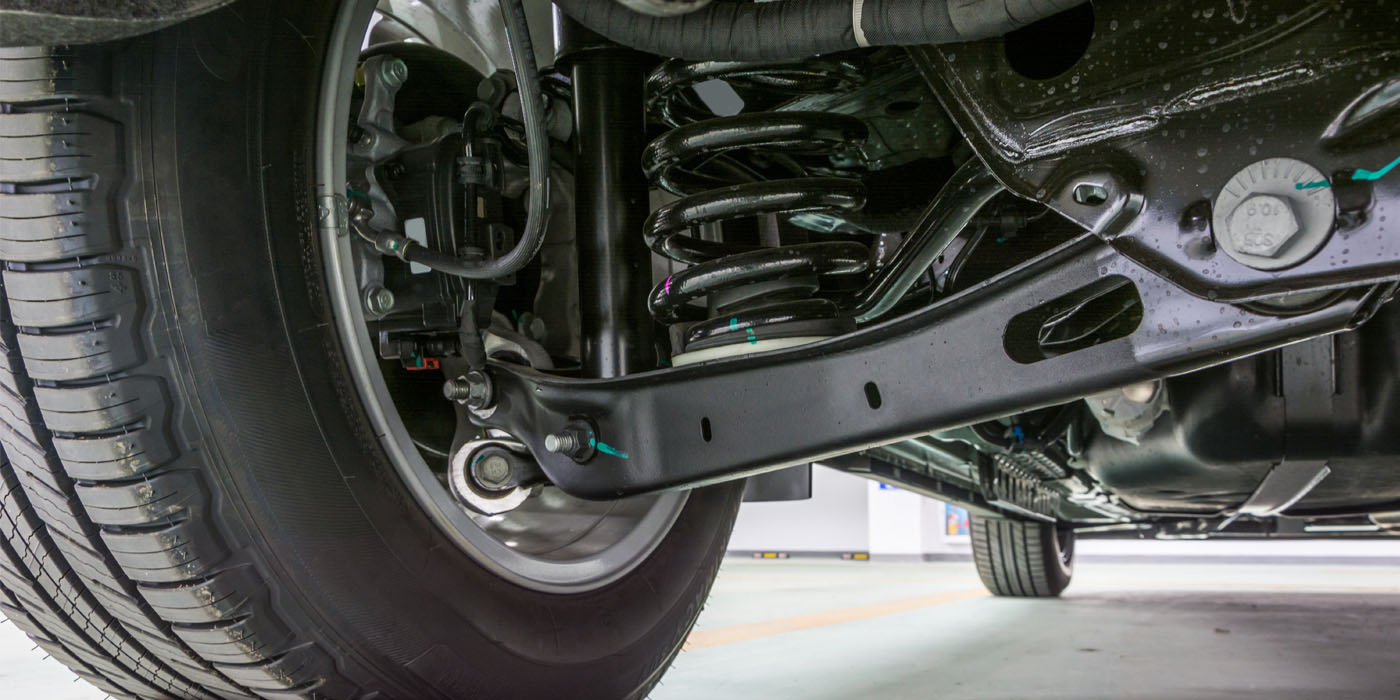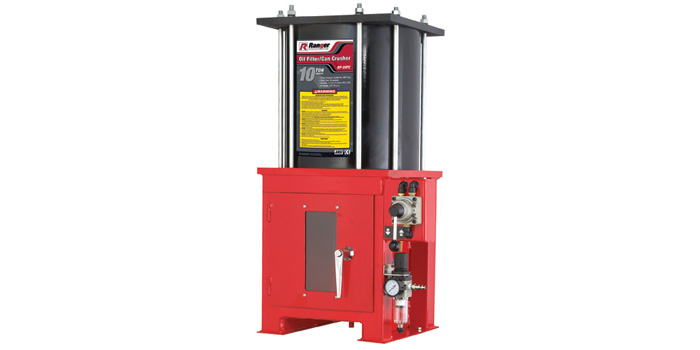It’s a cold, dark night. As you approach an intersection, you see a vehicle that’s going much too fast to notice the approaching stop sign – and he’s headed right for you. Your reflexes take over. You swerve and bounce over the curb and through the ditch, landing seemingly safely on high ground, so to speak.
No harm, no foul, right?
Not necessarily. The force that pushed you up and over the curb just may have bent some suspension items. Remember Newton’s third law: “For every action, there is an equal and opposite reaction.”
It’s not news to any of you reading this to say that collisions can cause a change to the alignment of a vehicle’s suspension components. In the example above, a very minor example of a collision, there are possibilities galore of what could have been bent. For example, the tie rod could have been affected something like this: The force starting at the curb then flows through tire, progressing through the wheel and onto the hub, spreading to the spindle via the bearings and onto the tie rod, with the steering rack opposing the opposite end of the tie rod, causing the weak link to bend.
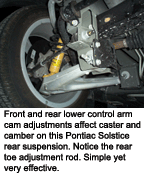
I know this is a long, drawn-out example, but it shows you just how complex our thought process should be when assessing even the simplest forms of collision damage.
My personal experience has been divided about 30/70 between in-house alignments versus sublet alignments. At the dealership I work at, we used to do all the alignments in house, and to this day, we keep the equipment to do so in working order. But these days, because of a qualified suspension technician shortage in our area and because we found an independent shop that was able to give us quality service at a reasonable price, we began subletting our final alignments. We had tried that in the past with less-than-wonderful results because we didn’t have a local independent shop with the experience needed to address the problems associated with collision repair alignments.
Regardless of how your shop handles the final alignment process, the following information will offer an idea of what to look for so you’ll have less trouble with your repairs in the shop.
The Basics
Let me start with just a few of the simpler terms and how they’re measured.
Camber: This is basically the tilt from vertical of the tire as viewed from the front. Positive camber can be described as out at the top, and negative camber just the opposite. Measurements can be basically made with a degreed bubble scale mounted at a right angle to the face of the wheel.
When assessing damage, the one measurement I look at first is camber. If the camber is off, it will most assuredly cause the toe to also be off – and possibly the caster, too. On the other hand, the toe usually doesn’t directly affect the camber or caster.
I have a couple of primitive items in my toolbox that I often pull out to give camber a preliminary check. One such item is a carpenter’s square. I check the wheel’s relationship to the ground by checking the square of the wheel with the ground, measuring the distance from the top or sometimes the bottom of the tire (in the case of positive camber) to the upright blade of the square, with the opposing blade flat on the ground next to the tire.
The other item in my toolbox is an old, inexpensive caster/camber gauge that’s designed to be clamped on the end of a spindle on the old-style suspensions. Instead, I often just hold it against a flat part of the hub or wheel to get a rough measurement. I do this with both wheels, comparing side to side. I’ve seen cases where one side will show positive camber while the opposite side will show negative camber, indicating a major problem. If both sides are comparable, odds are that your camber hasn’t been affected dramatically, and you can go on looking for other problems.
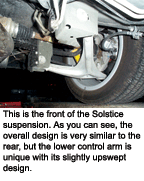
SAI Angle: This is also referred to as the kingpin inclination angle. It’s a measurement of the angle of the steering pivot line from the front compared to true vertical. It can be measured manually at the same time as caster, but it’s best to leave this measurement to an alignment machine. When you add this to your camber, it equates to what’s known as the “included angle.” I’m lumping the included angle with SAI because I rarely look at one without considering the other. Included angle is less well-known than the others, but it’s probably the measurement to look at the hardest when you have a camber problem. This measurement can be used to help you determine what part of your suspension is bent when you find your camber is out of specs.
Caster: A simple way to remember this is to think about the caster wheels on a shopping cart. The front wheels on a cart have negative caster, meaning they’re basically being drug along compared to the top pivot point. If you locked the wheels in a forward position to where the axle was forward of the top pivot point, this would be considered positive caster.
Measuring this isn’t quite as straightforward as camber. One way to do it is to take two camber measurements with the wheels turned a predetermined angle in one direction, and then with the wheels turned the same angle to the opposite direction – and then subtract the difference. Some vehicles have adjustable rear camber, and they don’t have steering that can be turned to help measure camber. On at least some of those vehicles, you must use a special gauge made just for measuring said angle on that specific vehicle.
When I’m checking a vehicle prior to sending it to the alignment shop in regard to caster, the first thing I check is the location of the ball joints. Some vehicles have an adjustable lower ball joint location, while others have stationary lower ball joints. My usual target when measuring the ball joints is the non-adjustable ball joint followed by the adjustable ones. If the ball joint’s fore and aft location is OK after you’ve checked to see that the camber is within range, then the alignment tech should have no problem adjusting the suspension to specs.
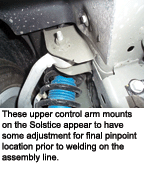
Toe: This is probably the easiest term to remember. Just think of your feet with your toes pointed toward each other; that would be considered toe “IN.” If they were pointed away from each other, then that would be considered toe “OUT.” Getting a diagnostic toe measurement is probably the easiest measurement for us to take. You basically need a straight line marked around the tires so you can measure the difference in width front and rear. The difference is toe out if the front measurement is more than the rear, and toe in if the front measurement is less than the rear.
I also want to mention that if the “toe out on turns” angle is out of specs, then that can be a hint of deeper problems. I’m sure most of you have been exposed to the Akerman angle idea of the inside wheel in a turn turning sharper than the outside wheel. The theory was developed in the 1800s during the horse-and-wagon era and is still applied with some altercations to today’s vehicles. Without getting any deeper into theory or history, let’s just say that straight ahead toe is by far the easiest to get right, but the applied Ackerman angle is a much better indicator of a front suspension’s health.
Problems Post-Repair
Occasionally we’ll encounter a complaint after the repair. The first thing a customer will notice, usually on his way home, is how the car drives and if the steering wheel is “straight.” I’ve had customers describe a “pulling” condition when the only problem was the wheel wasn’t centered, and the customer was actually turning the wheel to center and making the car “pull.” As obvious as it sounds, be sure someone drives the vehicle to confirm the repairs appear to be done right. Once customers realize they have to check your work, they will – and I mean they’ll scrutinize every detail once they get started. I’m guessing that you’d probably prefer a test drive over that.
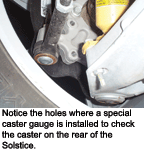
When we find, or have it pointed out to us, that there’s a problem that could be related to our alignment, we need to determine what has caused it. I have to admit, I’ve seen – and made – more than a few mistakes in trying to determine this. Sure, we could just send it to the alignment shop and ask, but some alignment technicians aren’t experienced in looking for collision damage — so that’s where we earn our money.
One problem I’ve encountered multiple times, as I’m sure most of you have, is a bent strut or a bent strut shaft. A bent strut housing will usually be easy enough to see. You usually see popped paint at the reinforced area where the knuckle attaches or other kinks and bends.
But a bent strut shaft isn’t as easily seen without a bit more effort. An easy check for a bent strut shaft is to loosen the nut on the top of the strut and give the shaft a spin with a socket while you watch the top of the tire for any camber changes. If the shaft is straight, the tire should remain virtually motionless, but when you find a bent one, the tire will waddle like an overfed duck!
Early in my career, I had such a bent strut throw me a curve. I knew the camber was off, and we sent the vehicle to an alignment tech to see what the vehicle needed. The alignment tech said he could slot the strut to get the camber readings he needed, and that’s what he did. So the vehicle was aligned using this method and returned to the customer.
All seemed fine until the customer came in almost a year later with a squawking noise that he said started shortly after the repair and got continually worse until he couldn’t put up with it anymore. He wasn’t happy.
The vehicle had a noise when you’d bounce it up and down severely on the right front corner. After further research (loosening the top nut and spinning the shaft), we found that the strut was bent. Upon disassembling the strut, you could even see a worn spot on the shaft where the bend was.
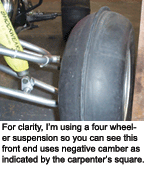
The slotting of the strut got the camber needed, but that turned out to be the proverbial Band-Aid disguising a deeper problem. If the technician involved in that repair (myself) wasn’t so intent on checking out the condition of the insides of his intestines, he might have suggested checking the SAI angle and also the toe out on turns. In doing so, we would have been able to diagnose the likelihood of the bent strut or knuckle or who knows what – preventing a lot of extra grief.
Cradle misalignment is another commonly overlooked problem. If the cradle is fore or aft of its intended position, it’ll cause a condition known as setback. If the cradle is misaligned side to side, it’ll cause camber and SAI angles to be different from side to side.
Setback will usually cause a cross caster difference and even cause tires to rub on turns on some of the cars that have less-than-extra tire clearance. Setback is called positive if the right wheel is further back than the left.
If a customer comes in with a “pulling” complaint, a vehicle will usually pull toward the most positive camber or the least positive caster. Many of the cars we work on have what’s considered no caster adjustment, so some alignment shops don’t even consider the caster on those – “If I can’t adjust it, why should I measure it?” That attitude can be detrimental to a quality repair and to your reputation. Cradle misalignment isn’t hard to repair, but you have to be aware of it before you can address it.
There are other causes of setback, too, such as something bent, possibly the cradle, frame or the lower control arm. But if we do our job before we send it to the alignment shop, we’ve already checked the ball-joint location – so this shouldn’t happen.
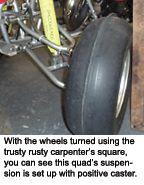
Bump steer has also fooled more than a few technicians and can be caused by a number of items. I’ve seen cases where a firewall-mounted rack was mounted on a bent firewall. We all know how hard the firewall is to see on many of these vehicles. The toe was off when the vehicle came in, and it had a bent tie rod. As the repair went, the tie rod was replaced, and the fact of the left tie rod adjustment showing many more threads than the opposing side was dismissed as “just one of those things.” After an unhappy customer insisted something was amiss, our research brought us to the bent firewall. But if we had checked the toe out on turns, we would have been able to see a hint toward our problem.
Another bump steer problem we had involved a late ’70s Chevy 4×4 that had been “lifted” by another shop. This one was easy enough because I had dealt with vehicles modified in a similar fashion before. A quick view from the side revealed a hint: The link between the pitman arm and the steering arm on the knuckle had a very steep angle, causing a right steering effect every time he hit even a minor bump.
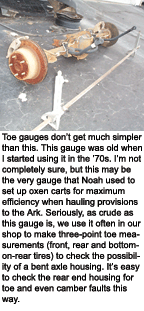
A good rule to remember is to look for parts that aren’t parallel or level. Pitman arms and idler arms should be parallel with the side of the vehicle, and they should be on a like plane with each other when viewed from the side. If the angle is sharper than intended, such as the tie rod going to the rack mentioned above or the steering link going to the knuckle, Newton’s third law will be right there to give you not only a bump steer, but also a bum steer.
When a collision compromises a vehicle’s suspension, it can change the relationship all the components have with each other, causing them to work against themselves. During the repair process, we shouldn’t treat the alignment as a last thing to be done; we should be assessing the alignment possibilities during every step of the repair.
I know the problems I listed here are far from complete, but it would take a book too large to carry in order to list all possible problems. I hope the ones I have mentioned will help you in your day-to-day repairs.
Straight Talk
All in all, suspension alignment has to be one of the most critical processes, and it involves more than sending it to an alignment shop. The basics of alignment are about having all the wheels working together and pointing cooperatively to roll toward our destination with the least resistance and the most stability.
We all know how important suspension alignment is to ride, drivability, fuel economy and, ultimately, customer satisfaction. So be a hero and take the extra steps it takes to evaluate a possible problem, and be sure whoever is doing your alignments cares as much as you do. After all, our entire repair will only appear as good or bad as the weakest link, which could be the alignment if we fail to do our part.
Contributing Editor Keith Combs is the body shop manager at Bill Roberts Chevrolet, where he’s been employed for more than 25 years. He was named GM/ASE Master Collision Repair/Refinish Technician of the year in 2000 and was one of the first to achieve GM’s World Class Technician status in 2002.







